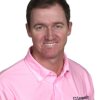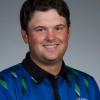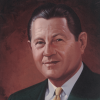(Augusta, GA.) Besides not having Tiger Woods in the field, the other major void is the famed Eisenhower Tree, the iconic loblolly pine found on the 17th hole, 210 yards off of the tee. It was lost in February when a major ice storm hit Augusta, causing substantial damage to the tree, the course and the entire Augusta area itself. In fact, in terms of the wider community itself, clean up from debris and fallen limbs was only completed last week in time for the Masters. After his Sunday practice round, Mark O’Meara was quoted as saying about the 17th hole, it “certainly looks way different.” The 1998 Masters champion also noticed the aftermath of the ice storm on the other holes. “A lot of trees have taken some serious damage,” said O’Meara, who played Sunday with former NFL receiver and Augusta National member Lynn Swann. Sunday was the last day that members could play the course.
Jimmy Walker in his interview said he played the course several weeks ago and noticed “a lot of guys up in the trees, a lot of chain saws going on.” Walker, a three time Tour winner this season, said the clean-up and pruning gave him “the feeling you could kind of see down through the golf course a little better—I don’t know if that’s a good thing or a bad thing.” Incidentally, Walker first played Augusta three years ago as guest of a member, allowing him to play the course along with his father and father-in-law. “It was neat. We got to stay on property and had dinner and played the par-3 and all of that.” Although his accommodations this week won’t be in a Masters cabin or lodge, Walker’s digs will be very close. He’s staying in an RV bus that’s parked across the street from club. “I mean, I’m walking in every day and it’s pretty nice.”
In his first player interview on Monday at the Press Center, first-time Masters invitee Patrick Reed handled himself quite well—especially when asked about his comments after his Doral win as being a “top 5 player in the world.” He said he received a number of favorable comments about the remark, including those from Gary Player, Henrik Stenson and Michael Jordan. “You have to believe in yourself,” said Reed. Nothing arrogant or cocky about that in this era of the pounced on soundbite.
It riles me when off-the-cuff, unscripted speech—like Reed’s words immediately after his Doral win—gets undue attention. Reed, in many circles, was viewed as cocky and arrogant and full of himself. But really, he just spoke his mind quickly—as would a Johnny Miller. I thought his Masters interview was revealing in how world-class players must confront and dismiss doubt. In fact, it recalled a line once uttered by Michigan’s Dave Hill when he played in the Grand Rapids Senior Open back in the late 80s. Hill said to a reporter, “You know, as a player I’m fighting doubt and self-doubt all of the time.” When asked if doubt ever creeps into his mind, Reed replied, “Not very often.” (laughter) Reed went to relate some of his mental tricks to ward off doubt when on the course. “Even if I’m in the trees and have an impossible shot, I always try to get some some belief or something positive out of it….So I try to keep on going back, if any kind of doubt starts to slip in my mind…You can’t—especially in this game, let doubt get in your way. I believe it’s just as much a mental game as physical game.”
Best quip of the day: By Jason Day when asked what advice he would lend to his fellow Aussies making their debut this week at the Masters: “Just try to give yourself an uphill putt.”
Best player insight. I asked Jason Day, one on one, what he learned upon reflection about last year’s Masters when he held the lead on Sunday at the 16th tee only to bogey the next two holes and fall off the pace. “Two things. One, I needed to have better communication with my caddie. We needed to talk it through better on the 16th tee. Second, I’ve learned to embrace the uncomfortable in that sort of situation. Since the Masters, I’ve done a better job of embracing that moment.”
Although no native Michiganders are competing in the 2014 Masters, the name of Ashwin Arasu should be noted. Arasu, 15, competed in the inaugural Drive, Chip & Putt National Finals in the Boys 14-15 age group. Now living in San Diego with his parents who are both Physical Therapists, Arasu was born in Dearborn, Michigan. Out of the 88 junior finalists, he was only one with Michigan roots. Next year, Michigan should have better odds on being represented as the event will hold nine locals around the state beginning in June, followed by three subregionals in August, and the finals in September. For details, visit www.drivechipandputt.com
By the way, the last Michigan resident to play in the Masters was Alma’s Randal Lewis. By winning the US Mid-Amateur in 2011, Lewis competed in the 2012 Masters. Michigan Tour players such as Tom Gillis, Justin Hicks, Doug LaBelle II, and Brian Stuard have yet to qualify for Masters. None of them have won a PGA Tour event or have qualified via other criteria, such as: 1) first four players and ties in the previous U.S. Open, British Open and/or PGA Championship; 2) those qualifying for the season-ending Tour Championship; 3) The 50 leaders on the Final Official World Golf Ranking; and 4) 50 leaders on the Official World Golf Ranking published the week before the current Masters.
The last Michigan pro to have played in the Masters was Marshall’s John Morse who played in the 1997 tournament. What a dry spell!
Speaking of Michigan ties with the Masters, the name of Horton Smith always pops up during the Masters week. Smith won the inaugural “Masters” (then called the Augusta National Invitational) in 1934. He later became the head golf professional at Detroit Golf Club and was president of the PGA of America in 1952-54. He passed away in Detroit in 1963. Smith, a member of the Michigan Golf Hall of Fame, won the ’34 tournament when the nines on the course were last played in reversed order, the original routing for the storied layout. He also won it again in 1936. In September 2013 Smith’s green jacket, from his 1934 Masters win, sold at auction for over $682,000. It’s believed to be highest price ever paid for a piece of golf memorabilia.
images courtesy of the PGA Tour and the Michigan Golf Hall of Fame



